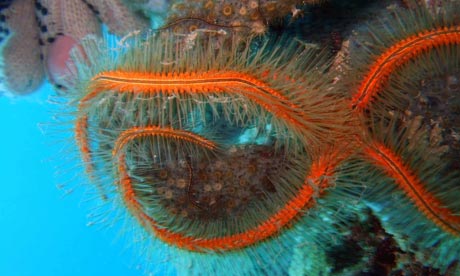Marine Life
Saturday 19 November 2011
Sunday 25 September 2011
MARINE LIFE
MARINE LIFE
- The oceans contain 99 percent of the living space on the planet.
- The blue whale, Balaenoptera musculus, is the largest known animal ever to have lived on sea or land. Individuals can reach more than 110 feet and weigh nearly 200 tons_more than the weight of 50 adult elephants. The blue whale's blood vessels are so broad that a full-grown trout could swim through them, and the vessels serve a heart the size of a small car.
- Hydrothermal vents, fractures in the sea floor that spew sulphur compounds, support the only complex ecosystem known to run on chemicals, rather than energy from the sun. Gigantic tubeworms and mussels thrive in densities of up to 65 pounds per square foot around vents.
- The oarfish, Regalecus glesne, is the longest bony fish in the world. With its snakelike body_sporting a magnificent red fin along its 50-foot length_horselike face and blue gills, it accounts for many sea-serpent sightings.
- Green turtles can migrate more than 1,400 miles to lay their eggs.
- A group of herring is called a seige. A group of jelly fish is called a smack.
- Many fish can change sex during the course of their lives. Others, especially rare deep-sea fish, have both male and female sex organs.
- Oils from the orange roughy, Hoplostethus atlanticus, a deep-sea fish from New Zealand, are used in making shampoo.
- Bluefin tuna, Thunnus thynnus, are among the largest and fastest marine fish. An adult may weigh 1,500 pounds and swim up to 55 miles per hour. Prized as sushi in Japan, bluefins are also among the most valuable fish: individual bluefins can bring as much as $20,000 at U.S. docks.
- Penguins "fly" underwater at up to 25 miles per hour.
- Since the architecture and chemistry of coral are very close to human bone, coral has been used to replace bone grafts in helping human bones to heal quickly and cleanly.
- Horseshoe crabs have existed in essentially the same form for the past 135 million years. Their blood provides a valuable test for the toxins that cause septic shock, which previously led to half of all hospital-acquired infections and one-fifth of all hospital deaths.
- Alginates, derived from the cell walls of brown algae, are used in beer, frozen desserts, pickles, adhesives, boiler compounds, ceramics, explosives, paper and toys.
- The remains of diatoms, algae with hard shells, are used in making pet litter, cosmetics, pool filters and tooth polish.
- One study of a deep-sea community revealed 898 species from more than 100 families and a dozen phyla in an area about half the size of a tennis court. More than half of these were new to science.
- Life began in the seas 3.1 billion to 3.4 billion years ago. Land dwellers appeared 400 million years ago_a relatively recent point in the geologic time line.
Subscribe to:
Posts (Atom)


